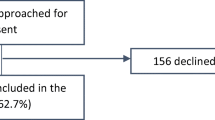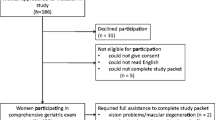Abstract
Purpose of Review
Frailty is highly prevalent with increasing age and contributes to adverse health outcomes. Prior to medical and surgical intervention for the treatment of pelvic floor disorders (PFD), a comprehensive evaluation is necessary to evaluate frailty. Beyond a standard assessment, the care of frail patients requires consideration of additional factors including functional ability, cognitive impairment, and the role of caregivers. In this article, we review the current literature on PFD, specifically urinary and fecal incontinence and pelvic organ prolapse, in frail individuals and highlight the risks and benefits of various treatment options.
Recent Findings
Multiple tools are available to screen and assess for frailty in the general population. Growing evidence demonstrates that the development of functional limitations is the initial manifestation of frailty and may further translate to an increased risk of surgical complications.
Summary
No standardized method for screening and measurement of frailty currently exists. Independent of the individual assessment metric to measure frailty, there is an associated increased risk of adverse events related to treatments. Management of PFD in the frail population requires a tailored approach and necessitates consideration beyond objective data to the subjective, cognitive, and quality of life implications of treatment.
Similar content being viewed by others
References
Papers of particular interest, published recently, have been highlighted as: • Of importance
Brown I, Renwick R, Raphael D. Frailty: constructing a common meaning, definition, and conceptual framework. Int J Rehabil Res. 1995;18(2):93–102.
Collard R, Boter H, Schoevers R, Oude VR. Prevalence of frailty in community-dwelling older persons: a systematic review. J Am Geriatr Soc. 2012;60(8):1487–92.
Fried LP, Tangen CM, Walston J, Newman AB, Hirsch C, Gottdiener J, et al. Frailty in older adults: evidence for a phenotype. J Gerontol A Biol Sci Med Sci. 2001;56(3):M146–56.
Makary MA, Segev DL, Pronovost PJ, Syin D, Bandeen-Roche K, Patel P, et al. Frailty as a predictor of surgical outcomes in older patients. J Am Coll Surg. 2010;210(6):901–8.
Nygaard I, Barber MD, Burgio KL, Kenton K, Meikle S, Schaffer J, et al. Prevalence of symptomatic pelvic floor disorders in US women. JAMA. 2008;300(11):1311–6.
Shinnick JK, Raker CA, Sung V. Provider miscategorization of frailty in an outpatient urogynecologic population. Int Urogynecol J [Internet]. 2019; [cited 2020 Apr 1]; Available from: http://link.springer.com/10.1007/s00192-019-04095-5.
Abellan van Kan G, Rolland Y, Andrieu S, Bauer J, Beauchet O, Bonnefoy M, et al. Gait speed at usual pace as a predictor of adverse outcomes in community-dwelling older people an International Academy on Nutrition and Aging (IANA) Task Force. J Nutr Health Aging. 2009;13(10):881–9.
Savva GM, Donoghue OA, Horgan F, O’Regan C, Cronin H, Kenny RA. Using timed up-and-go to identify frail members of the older population. J Gerontol Ser A Biol Med Sci. 2013;68(4):441–6.
Abellan van Kan G, Rolland Y, Houles M, Gillette-Guyonnet S, Soto M, Vellas B. The assessment of frailty in older adults. Clin Geriatr Med. 2010;26(2):275–86.
Bautmans I, Gorus E, Njemini R, Mets T. Handgrip performance in relation to self-perceived fatigue, physical functioning and circulating IL-6 in elderly persons without inflammation. BMC Geriatr. 2007;7:5.
Syddall H, Cooper C, Martin F, Briggs R, Aihie SA. Is grip strength a useful single marker of frailty? Age Ageing. 2003;32(6):650–6.
Abellan van Kan G, Rolland YM, Morley JE, Vellas B. Frailty: toward a clinical definition. J Am Med Dir Assoc. 2008;9(2):71–2.
Saliba D, Elliott M, Rubenstein LZ, Solomon DH, Young RT, Kamberg CJ, et al. The vulnerable elders survey: a tool for identifying vulnerable older people in the community. J Am Geriatr Soc. 2001;49(12):1691–9.
• Amin KA, Lee W, Moskowitz D, Kobashi KC, Lucioni A, Reed MJ, et al. A Rapid Method to Preoperatively Assess Frailty for Older Patients with Pelvic Floor Conditions. J Urol. 2020 Jan 2;1172–7. Most frailty assessment tools are often too cumbersome to perform in the clinical setting. This study demonstrates that CFS-9 is an excellent predictor of frailty compared to the Fried Frailty Index for patients with pelvic floor conditions and is easily administered.
Rano M, Hird AE, Refik S, Radomski SB, Lesley C, Kodama RT, et al. Is there an association between urinary incontinence and mortality? A retrospective cohort study. J Urol. 2020;203(3):591–7.
Overactive bladder (OAB) guideline - American Urological Association [Internet]. [cited 2020 Mar 30]. Available from: https://www.auanet.org/guidelines/overactive-bladder-(oab)-guideline
• Coupland CAC, Hill T, Dening T, Morriss R, Moore M, Hippisley-Cox J. Anticholinergic Drug Exposure and the Risk of Dementia: A Nested Case-Control Study. JAMA Intern Med. 2019 Jun 24;(8):1084–93. Pharmacologic management with anticholinergics is the second-line treatment for patients with urge urinary incontinence. While anticholinergics have short-term cognitive side effects, this study observed an association between dementia and exposure to several anticholinergic medications, suggesting that these drugs should be prescribed with caution in older, frail adults.
Usmani SA, Reckenberg K, Johnson O, Stranges PM, Teshome BF, Kebodeaux CD, et al. Relative risk of adverse events and treatment discontinuations between older and non-older adults treated with antimuscarinics for overactive bladder: a systematic review and meta-analysis. Drugs Aging. 2019;36(7):639–45.
Richter H, Amundsen C, Erickson S, Jelovsek J, Komesu Y, Chermansky C, et al. Characteristics associated with treatment response in women undergoing onabotulinumtoxinA and sacral neuromodulation for refractory urgency urinary incontinence. J Urol. 2017;198(4):890–6.
Suskind AM, Kowalik C, Quanstrom K, Boscardin J, Zhao S, Reynolds WS, et al. The impact of frailty on treatment for overactive bladder in older adults. Neurourol Urodyn. 2019;38(7):1915–23.
Liao C-H, Hann-Chorng K. Increased risk of large post-void residual urine and decreased long-term success rate after Intravesical onabotulinumtoxinA injection for refractory idiopathic detrusor overactivity. J Urol. 2013;189(5):1804–10.
Cohen AJ, Packiam VT, Nottingham CU, Alberts BD, Faris SF, Bales GT. 30-day morbidity and reoperation following midurethral sling: analysis of 8772 cases using a national prospective database. Urology. 2016;95:72–9.
Saga S, Vinsnes AG, Mørkved S, Norton C, Seim A. Prevalence and correlates of fecal incontinence among nursing home residents: a population-based cross-sectional study. BMC Geriatr. 2013;13:87.
Solon JG, Waudby P, O’Grady H. Percutaneous tibial nerve stimulation can improve symptoms and quality of life in selected patients with faecal incontinence – a single-centre 5-year clinical experience. The Surgeon [Internet]. 2019; [cited 2020 Apr 1]; Available from: http://www.sciencedirect.com/science/article/pii/S1479666X19301088.
Luber KM, Boero S, Choe JY. The demographics of pelvic floor disorders: current observations and future projections. Am J Obstet Gynecol. 2001;184(7):1496–501 discussion 1501-1503.
Maher C, Feiner B, Baessler K, Schmid C. Surgical management of pelvic organ prolapse in women. Cochrane Database Syst Rev. 2013;4:CD004014.
Bodner-Adler B, Bodner K, Stinglmeier A, Kimberger O, Halpern K, Koelbl H, et al. Prolapse surgery versus vaginal pessary in women with symptomatic pelvic organ prolapse: which factors influence the choice of treatment? Arch Gynecol Obstet. 2019;299(3):773–7.
Catanzarite T, Rambachan A, Mueller MG, Pilecki MA, Kim JYS, Kenton K. Risk factors for 30-day perioperative complications after Le Fort colpocleisis. J Urol. 2014;192(3):788–92.
Suskind AM, Jin C, Walter LC, Finlayson E. Frailty and the role of obliterative versus reconstructive surgery for pelvic organ prolapse; a national study. J Urol. 2017;197(6):1502–6.
Narins H, Danforth TL. Management of pelvic organ prolapse in the elderly - is there a role for robotic-assisted sacrocolpopexy? [Internet]. Vol. 3, Robotic Surgery: Research and Reviews. Dove Press; 2016 [cited 2020 Mar 25]. p. 65–73. Available from: https://www.dovepress.com/management-of-pelvic-organ-prolapse-in-the-elderly-ndash-is-there-a-ro-peer-reviewed-fulltext-article-RSRR
Murphy M, Sternschuss G, Haff R, van Raalte H, Saltz S, Lucente V. Quality of life and surgical satisfaction after vaginal reconstructive vs obliterative surgery for the treatment of advanced pelvic organ prolapse. Am J Obstet Gynecol. 2008;198(5):573.e1–7.
Barber MD, Amundsen CL, Paraiso MFR, Weidner AC, Romero A, Walters MD. Quality of life after surgery for genital prolapse in elderly women: obliterative and reconstructive surgery. Int Urogynecol J Pelvic Floor Dysfunct. 2007;18(7):799–806.
Sung VW, Weitzen S, Sokol ER, Rardin CR, Myers DL. Effect of patient age on increasing morbidity and mortality following urogynecologic surgery. Am J Obstet Gynecol. 2006;194(5):1411–7.
Pizarro-Berdichevsky J, Clifton MM, Goldman HB. Evaluation and management of pelvic organ prolapse in elderly women. Clin Geriatr Med. 2015;31(4):507–21.
Krlin RM, Soules KA, Winters JC. Surgical repair of pelvic organ prolapse in elderly patients. Curr Opin Urol. 2016;26(2):193–200.
Moore T, Tubman I, Levy G, Brooke G. Age as a risk factor for perioperative complications in women undergoing pelvic reconstructive surgery. Female Pelvic Med Reconstr Surg. 2010;16(5):290–5.
Nieminen K, Heinonen PK. Sacrospinous ligament fixation for massive genital prolapse in women aged over 80 years. BJOG. 2001;108(8):817–21.
Geller EJ, Siddiqui NY, Wu JM, Visco AG. Short-term outcomes of robotic sacrocolpopexy compared with abdominal sacrocolpopexy. Obstet Gynecol. 2008;112(6):1201–6.
Geller EJ, Parnell BA, Dunivan GC. Robotic vs abdominal sacrocolpopexy: 44-month pelvic floor outcomes. Urology. 2012;79(3):532–6.
Funding
No funding was received.
Author information
Authors and Affiliations
Corresponding author
Ethics declarations
Conflict of Interest
Dr. Sida Niu, Dr. Tomas Griebling, and Dr. Casey Kowalik declare that they have no conflicts of interest.
Human and Animal Rights and Informed Consent
This article does not contain any studies with human or animal subjects performed by any of the authors.
Additional information
Publisher’s Note
Springer Nature remains neutral with regard to jurisdictional claims in published maps and institutional affiliations.
This article is part of the Topical Collection on Reconstructed Bladder Function & Dysfunction
Rights and permissions
About this article
Cite this article
Niu, S., Griebling, T.L. & Kowalik, C.G. Impact of Frailty on the Treatment of Pelvic Floor Disorders. Curr Bladder Dysfunct Rep 15, 121–126 (2020). https://doi.org/10.1007/s11884-020-00590-4
Published:
Issue Date:
DOI: https://doi.org/10.1007/s11884-020-00590-4




